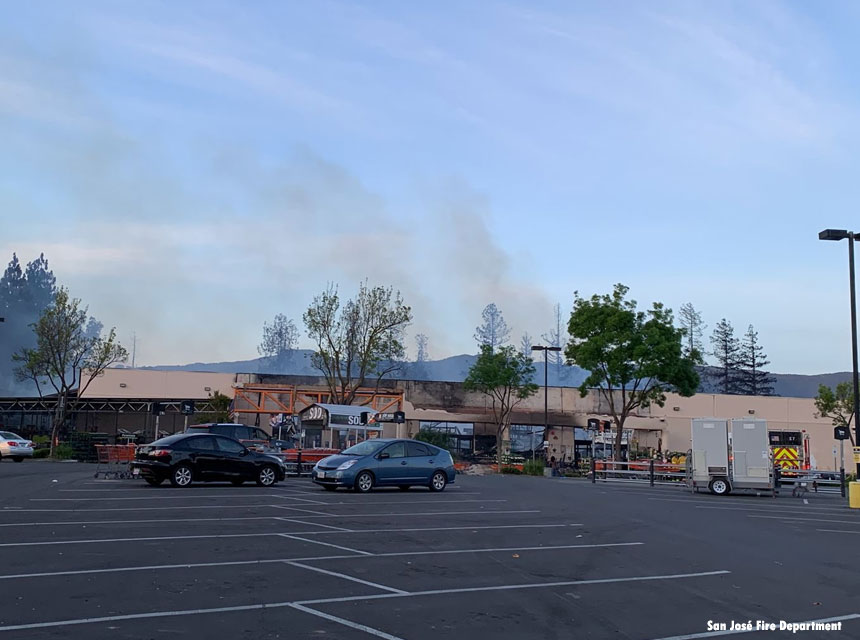
By Dr. Vyto Babrauskas
Fully-sprinklered warehouse or big-box-store buildings should be safe from fire. We generally believe that this is true, provided there is no major external disaster (the city loses its water supply, an airplane crashes into the building, etc.). Yet recent events have proven otherwise. In December 2021, a QVC warehouse in North Carolina was destroyed. In March 2022, a Walmart big-box store in Indiana was destroyed, while in April 2022, a Home Depot center in San Jose became a pile of rubble. These were all fully-sprinklered facilities, with sprinkler systems presumably designed by competent engineers. Yet they burned down into huge, flaming messes.
As with any major loss, it will likely take a year or two before various involved parties finish figuring what went wrong and who might be the responsible party. The details will likely prove different for each case. But while the memories are still fresh, we should start trying to figure out how the fire safety profession could do better. Three very similar major incidents in the space of five months are not something we can be proud of.
How Does a Fully Sprinklered Warehouse Burn to the Ground?
Here, we will focus on three systematic shortcomings which may continue to lead to similar disasters in the future.
(1) National Fire Protection Association (NFPA) sprinkler protection rules based on unavailable research.
I have had forensic consulting experience with warehouse fires for several decades now. And I have been able to get a perspective which may not be available to those not involved in such work. Sprinkler protection of warehouse occupancies used to be governed by NFPA Standard 231C, Standard for General Storage. In 1999, this standard was withdrawn, and sprinkler protection of warehouses was merged into the general standard on sprinkler protection, NFPA 13, Standard for the Installation of Sprinkler Systems. Whether in the old standard or in the current one, we need to ask how proper instructions for providing sprinkler protection in warehouses have evolved.
The answer is that, with a very few exceptions, the actual provisions are based on testing work done by FM Global in their large-scale fire test facility. But this is where the problem comes in. The FM research gets written up in a comprehensive test report. But this report is generally not available to fire protection design engineers, apart from a few documents posted on their website. Copies are provided to members of the NFPA 13 committee, plus any manufacturers or other entities that might have sponsored this particular research. But the person who really needs this information—the engineer designing the fire protection for a particular facility—is not given access to this information. They must solely rely on the very terse verbiage of the changes to NFPA 13 that are proposed as a consequence of this research. I strongly encourage FM Global to rethink this policy and make the full technical details always available to the profession.
(2) Lack of a robust system to ascertain that sprinkler protection matches, and continues matching, the hazard involved.
I have been personally involved with a number of fires in very large buildings where the reason for sprinkler failure was because, although the system may have been satisfactory for the fuel load originally contemplated, the latter changed, whereas the former did not. In general, there can be two responsible parties: the owner, or the authority having jurisdiction (AHJ). Not every owner is aware that sprinkler system effectiveness is wholly dependent on being matched to the fuel load involved. Thus, they have been known to change the fuel load, without even realizing that an engineering firm needs to be hired to re-evaluate the sprinkler protection. In principle, the AHJ is the fallback position for ensuring safety. But effectiveness here seems to rarely happen. First of all, a sizable fraction of warehouse facilities are in small towns or rural areas, where the expertise of the building department staff is likely to be limited. But also, assessing whether there is a match between the level of sprinkler protection and the hazard of the fuel load requires study by a competent fire protection engineer. It is not something that can be assessed by eyeballing the facility. Even a highly qualified engineer will need to make a detailed study to obtain the proper answer.
The ownership of a facility may not change, and its occupancy classification can remain the same. But the fuel load hazard can change. Yet the fire codes do not have a good way of dealing with this situation. The problem is that the International Building Code (IBC) only recognizes two storage (“S”) occupancy groups, while actual hazards are much more varied. And fire codes do not ask the question: Has the fuel load hazard changed in this S-1 occupancy to require a re-design of the sprinkler system? This is an area where the codes should be further developed to address this specific problem.
(3) Questions of safety margin for sprinkler system effectiveness.
Sprinkler system protection of warehouse buildings is tricky because the challenge/response relationship is extremely nonlinear. If we progressively increase the hazard, the sprinkler system response will basically be unchanged up to a certain point. Beyond that point, things will change abruptly from full success to tragic failure. This suggests that the safety margin for the design should be carefully evaluated, and that the design be assured of not being too close to the zero-mark. This, however, is presently hard to do. NFPA 13 does not recognize the concept of a safety margin, nor are there accepted procedures within the engineering profession to routinely address this.
VYTO BABRAUSKAS, Ph.D., is with Fire Science and Technology Inc., in Clarkdale, Arizona. He is also associated with the John Jay College of Criminal Justice in New York.
This commentary reflects the views of the authors and not necessarily the views of Fire Engineering.

